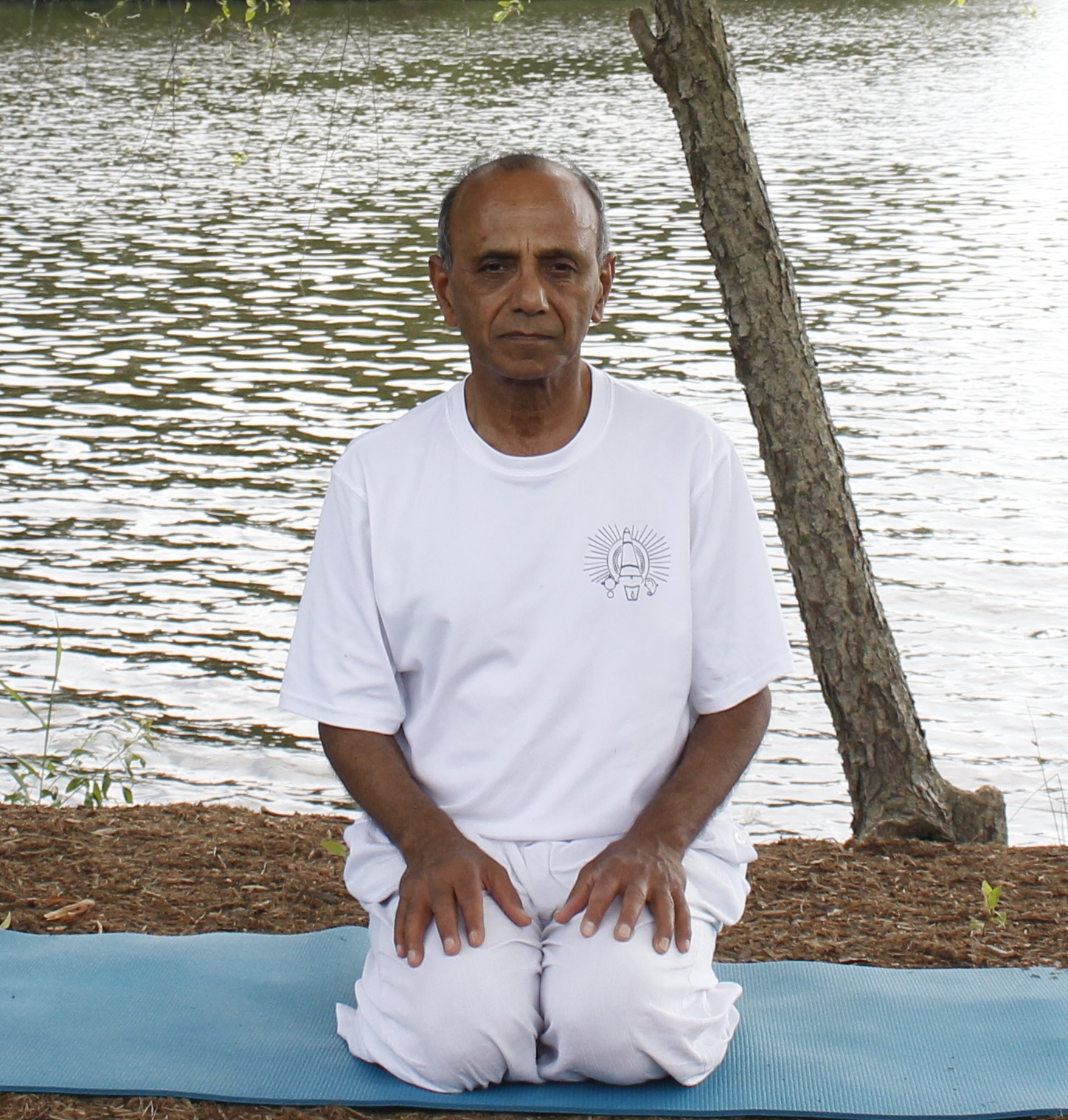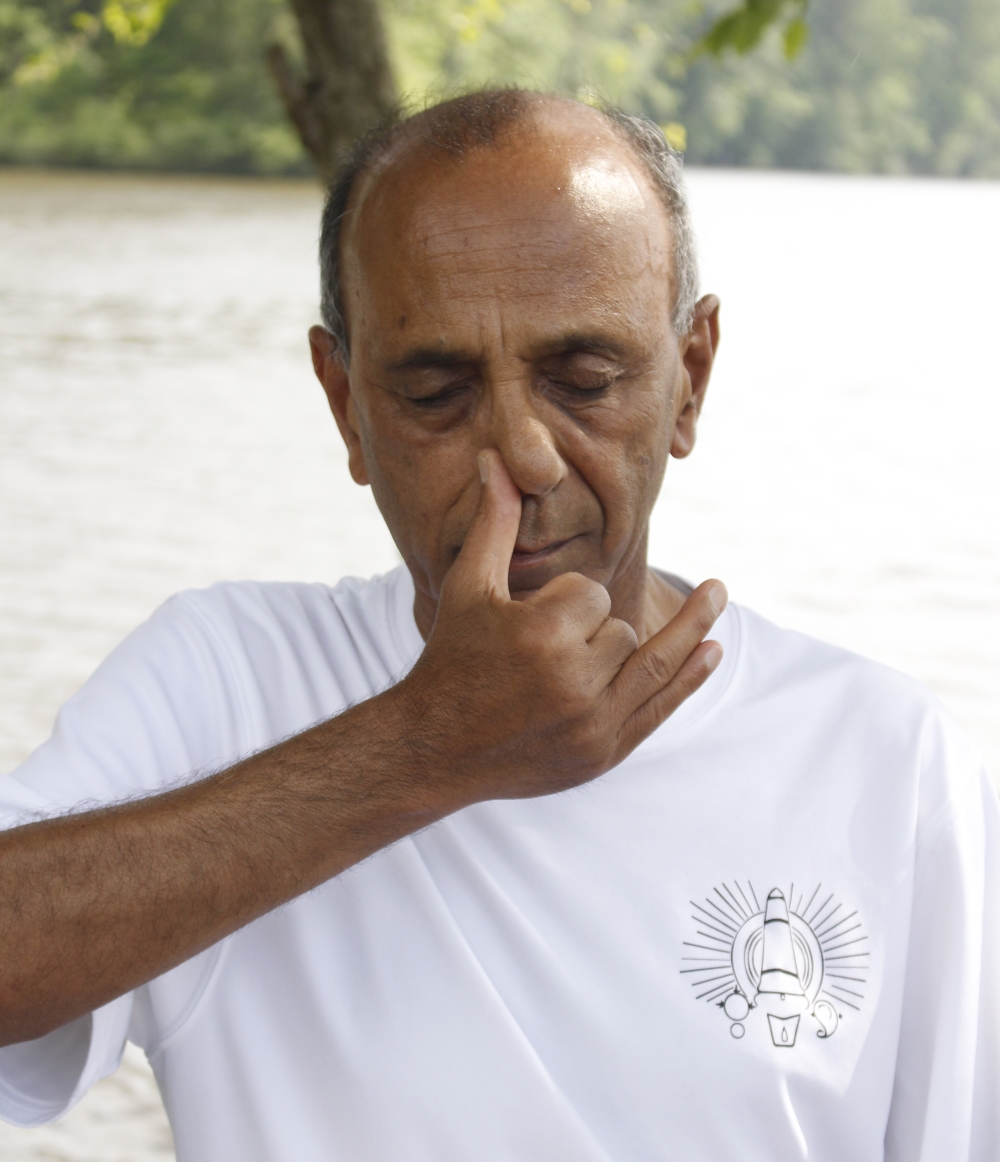
Vajrasana
In some of the earlier articles, I have discussed the concepts of Kumbhaka (breath retention) and the Bandhas (energy locks) as part of the common pranayama practices. In this article I would like to introduce kumbhaka and bandhas as an extension of the Kapalabhati practice.
If you have attended a yoga class with me, you are aware that the practice of Kapalabhati is an integral part of the yoga routine that we practice in the class. In fact, we practice at least one round of Kapalabhati at the beginning of the class, right after we do the cat and cow stretch (Marjarasana) as a gentle spinal warm up. In the last segment of the class again, we include more kapalabhati as part of the pranayama routine.
As a cautionary note I would like to emphasize here that these advanced practices involving kumbhaka and bandhas should be learned under the guidance of a qualified teacher. In general, you should practice the basic techniques of pranayama without kumbhaka and bandhas for at least six to eight weeks on a regular basis before attempting these advanced techniques.
I hope you will enjoy practicing with this video sequence.
Bandhas Overview
There are three bandhas which are practiced as a part of the pranayama routine:
- Mula Bandha – मूलबन्ध – (root lock)
- Uddiyana Bandha – उड्डियान बन्ध – (navel lock)
- Jalandhara Bandha – जालन्धर बन्ध – (chin lock)
These bandhas are normally applied while holding the breath, either at the end of inhalation or at the end of exhalation. The root lock and the chin lock can be applied both at the end of inhalation as well as after exhalation. However, the navel lock can be effectively applied only after a complete exhalation. These locks are maintained as long as the breath is being retained. The locks should be released before resuming the breathing cycle. When all the three locks are applied together at the end of exhalation, it is called "Maha Bandha" or the Great Lock.
Mula Bandha (Root Lock)
To apply the root lock, squeeze the perineum area inward from all sides and then lift the anus muscles upward. The awareness during the root lock is focused at the Muladhara Chakra (the root chakra), located at the spot which as about the width of two fingers above the anus.
Jalandhara Bandha (Chin Lock)
The chin lock is applied by lowering the chin to the chest while lifting the sternum upward. While holding the lock, a gentle pressure should be maintained with the chin against the chest.
Uddiyana Bandha (Navel Lock)
As mentioned above, the navel lock is effectively applied only after a complete exhalation. At the end of exhalation, try to suck the belly all the way back toward the spine. While holding the navel lock, the chin lock is simultaneously applied.
Kapalabhati with Bandhas
Kumbhaka and bandhas are applied at the end of each round of Kapalabhati (KB). As I have mentioned in some earlier posts, I recommend three rounds of KB, each round consisting of about 100-120 breath expulsions (or a number that you are comfortable with), with a short period of rest between rounds.
Step-by-step

Vishnu Mudra
- Sit in any comfortable sitting posture. In my own practice, for the practice of Kapalabhati, I prefer to sit in the Vajrasana. However, you should sit in any of the sitting asanas that you are naturally comfortable in.
- Begin the practice of kapalabhati. Try to maintain a uniform rhythm of breath expulsions. You can use the ticking sound of a metronome to help you with the rhythm. Do as many breath expulsions as you are comfortable with.
- When you finish the round of KB, take an inhalation and then expel all the air out of the lungs.
- While retaining the breath out in Bahya kumbhaka (external breath retention), try to apply all three bandhas – Mula Bandha (root lock), Uddiyana Bandha (navel lock) and Jalandhara Bandha (chin lock), also known as Maha Bandha (great lock). Maintain the locks for a comfortable duration.
- When you have the urge to inhale, release all the three locks – lift the chin back to the neutral position, soften the abdomen and the perineum area. Using the Vishnu Mudra with the right hand (see picture), close the left nostril with the ring finger and begin a deep, soft and smooth inhalation through the right nostril using the Ujjayi breathing technique.
- At the end of inhalation, close both the nostrils using the thumb and the ring finger and apply both Jalandhara Bandha (chin lock) and the Mula Bandha (root lock).
- Hold the bandhas for a duration that is comfortable. When you have the urge to exhale, release the bandhas and, closing the right nostril with the thumb, exhale through the left nostril.
- This completes one cycle of KB. After a brief period of rest, repeat the same technique for the next two rounds of KB.
Benefits
- As mentioned in the Hatha Yoga Pradipika, Kapalabhati is considered one of the cleansing techniques in yoga. One of its main benefits comes in the form of movement of metabolic waste from all the tissues in the body toward the lungs where they are eliminated.
- Kapaalabhaati helps clear mucus from the lungs. As air moves into the throat, it travels down the superior portion of the airway called the trachea. The walls of this single tubed airway consist of several layers, of which the innermost layer is lined with cilia cells. Cilia are microscopic, grass-like projections that continually beat and propel mucus that traps dust particles, bacteria and debris. This mucus is propelled by the cilia toward the pharynx where it is released by coughing or swallowing. Smoking inhibits and ultimately destroys cilia. When the cilia function, as described above, is lost, coughing is the only method of moving accumulated mucus out of the lungs. Because of the cleansing effect on the lungs, this practice is recommended for people who suffer from respiratory ailments like bronchitis, asthma, tuberculosis etc.
- The force of the exhalations in Kapaalabhaati acts further on debris-filled mucus in the lungs and trachea. This additional force works with the cilia and helps move the mucus more readily up the airway against gravity. Coughing after Kapaalabhaati helps in releasing these impurities. In addition to removing mucus, Kapaalabhaati also helps expel more carbon dioxide and other waste gases from the cells and lungs compared to normal breathing. The powerful exhalation also helps increase the flow of blood in the lung tissues as well as throughout the body.
- Improves the health of the lungs, bronchial system and the associated organs. It helps in curing the diseases of the lungs like asthma and bronchitis.
- The energetic expulsions in Kapalabhati help increase cardiovascular activity and increasing the heart rate. This helps in improving the health of the heart muscles and tissues.
- The rapid and forceful movement of the abdominal muscles in Kapaalabhaati gives a massage to the internal organs. With each vigorous exhalation, the abdominal walls draw inwards applying pressure on internal organs, including the lungs, pancreas, intestines, the gall bladder etc. This pressure helps increase the circulation of blood flow into and out of abdominal organs. This massage also sends a direct pressure into the digestive system helping move remaining food and fecal matter through the intestines and colon. Kapaalabhaati helps in reducing the incidence of constipation. With this increased circulation of blood and material in the internal organs comes a release of toxins as well.
- At a subtler level, it impacts the Navel Center (Manipura Chakra) and helps in countering some of the negative propensities associated with this chakra – jealousy, shame, fear, disgust, delusion, and sadness.
- Literally, the word kapaalabhaati means ‘skull shining’ (kapaala = skull; bhaati = shining/polishing). Regular practice is supposed to clear and calm the mind and over a period of time, one develops a healthy natural glow on the face.
- It also brings about the state of ‘pratyahara’ (sense withdrawal) which prepares the mind for meditation.
Added Benefits of Bandhas
(from the book "Asana, Pranayama, Mudra, Bandha from Bihar School of Yoga)
Maha bandha (great lock – simultaneous application of Mula, Uddiyana and Jalandhara bandhas) gives enhanced benefits of all three bandhas. It affects the hormonal secretions of the pineal gland and regulates the entire endocrine system. The degenerative and ageing processes are checked and every cell of the body is rejuvenated. It introverts the mind prior to meditation. When perfected, it can fully awaken prana in the main chakras. It leads to the merger of prana, apana and samana in manipura chakra, which is the culmination of all pranayamas.
Contraindications
People with the following conditions should not practice kapaalabhaati – cardiac problems, nasal congestion, severe cold, severe headache, abdominal ulcers, hernia. People with high blood pressure should either refrain from it or practice a milder version of the technique. Pregnant women and those who have had recent abdominal surgery should also refrain from this practice. One cautionary note – practice kapaalabhaati on an empty stomach, preferably in the morning. However, if your schedule only allows you to practice it during the day/evening, then you should give a gap of at least 2.5 hours after eating a meal.
Recent Comments